Assessment of Mr. Bright's Case Study: Clinical Simulation 6 Report
VerifiedAdded on 2021/04/16
|7
|1539
|64
Report
AI Summary
This report analyzes a clinical simulation centered on Mr. Bright, a patient who underwent an angioplasty. The first part of the report evaluates the initial nursing assessment, detailing the collection of patient history, pre-procedural orientation, and the importance of family support. It highlights the significance of post-operative care, including monitoring vital signs and managing potential complications related to the femoral access route. The report also discusses the importance of patient education, and the need for lifestyle modifications. The second part of the report uses the ISBAR tool to structure communication regarding Mr. Bright's case, providing a clear overview of his situation, background, assessment findings (including vital signs and BGL), and recommendations for his care. The report emphasizes the importance of comprehensive patient assessment and communication in ensuring positive patient outcomes. The report also identifies areas where the provided care could be improved, particularly in patient education and emergency preparedness.

Running head: CLINICAL SIMULATION
Assessment of Mr. Bright’s case study
Name of the Student
Name of the University
Author Note
Assessment of Mr. Bright’s case study
Name of the Student
Name of the University
Author Note
Paraphrase This Document
Need a fresh take? Get an instant paraphrase of this document with our AI Paraphraser
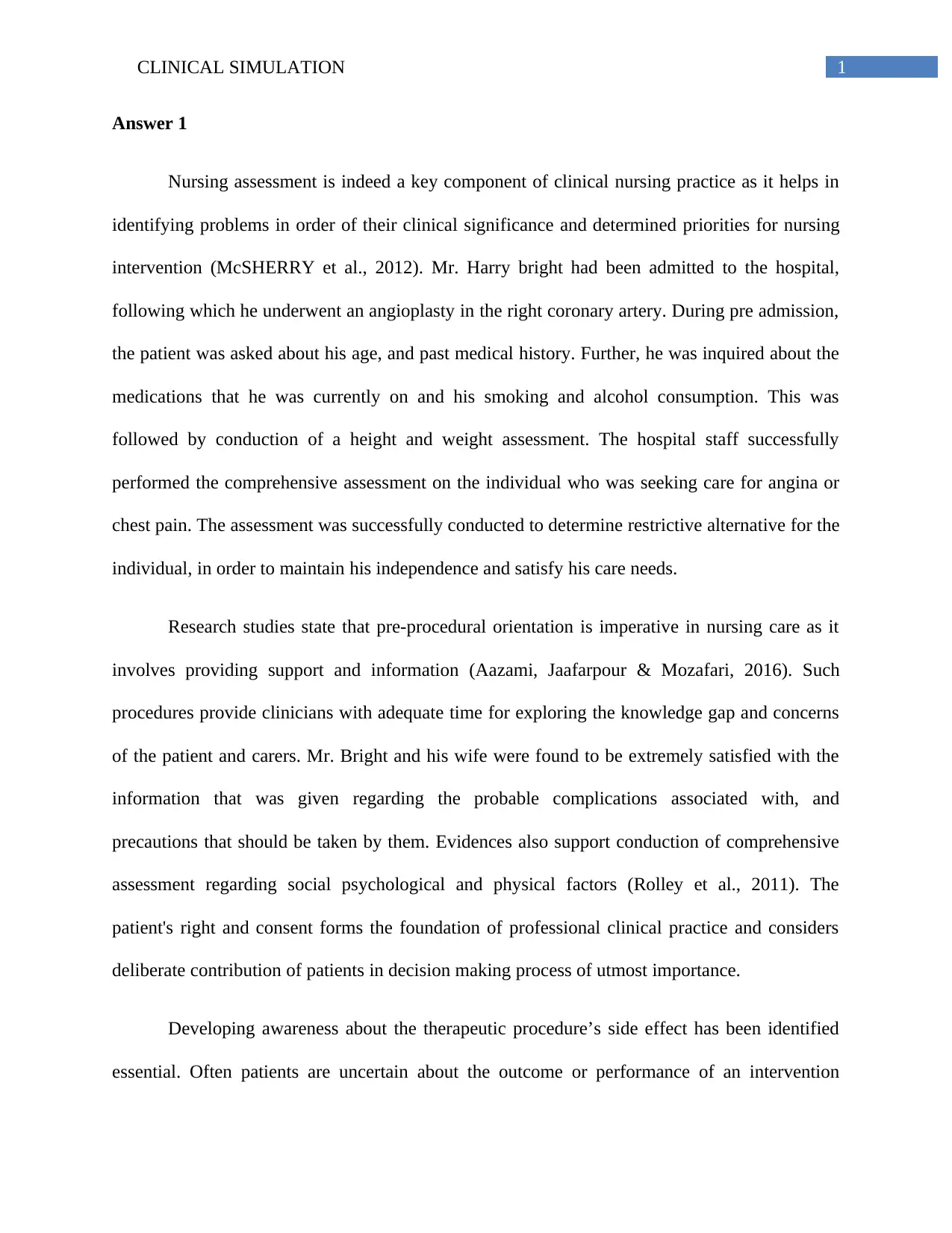
1CLINICAL SIMULATION
Answer 1
Nursing assessment is indeed a key component of clinical nursing practice as it helps in
identifying problems in order of their clinical significance and determined priorities for nursing
intervention (McSHERRY et al., 2012). Mr. Harry bright had been admitted to the hospital,
following which he underwent an angioplasty in the right coronary artery. During pre admission,
the patient was asked about his age, and past medical history. Further, he was inquired about the
medications that he was currently on and his smoking and alcohol consumption. This was
followed by conduction of a height and weight assessment. The hospital staff successfully
performed the comprehensive assessment on the individual who was seeking care for angina or
chest pain. The assessment was successfully conducted to determine restrictive alternative for the
individual, in order to maintain his independence and satisfy his care needs.
Research studies state that pre-procedural orientation is imperative in nursing care as it
involves providing support and information (Aazami, Jaafarpour & Mozafari, 2016). Such
procedures provide clinicians with adequate time for exploring the knowledge gap and concerns
of the patient and carers. Mr. Bright and his wife were found to be extremely satisfied with the
information that was given regarding the probable complications associated with, and
precautions that should be taken by them. Evidences also support conduction of comprehensive
assessment regarding social psychological and physical factors (Rolley et al., 2011). The
patient's right and consent forms the foundation of professional clinical practice and considers
deliberate contribution of patients in decision making process of utmost importance.
Developing awareness about the therapeutic procedure’s side effect has been identified
essential. Often patients are uncertain about the outcome or performance of an intervention
Answer 1
Nursing assessment is indeed a key component of clinical nursing practice as it helps in
identifying problems in order of their clinical significance and determined priorities for nursing
intervention (McSHERRY et al., 2012). Mr. Harry bright had been admitted to the hospital,
following which he underwent an angioplasty in the right coronary artery. During pre admission,
the patient was asked about his age, and past medical history. Further, he was inquired about the
medications that he was currently on and his smoking and alcohol consumption. This was
followed by conduction of a height and weight assessment. The hospital staff successfully
performed the comprehensive assessment on the individual who was seeking care for angina or
chest pain. The assessment was successfully conducted to determine restrictive alternative for the
individual, in order to maintain his independence and satisfy his care needs.
Research studies state that pre-procedural orientation is imperative in nursing care as it
involves providing support and information (Aazami, Jaafarpour & Mozafari, 2016). Such
procedures provide clinicians with adequate time for exploring the knowledge gap and concerns
of the patient and carers. Mr. Bright and his wife were found to be extremely satisfied with the
information that was given regarding the probable complications associated with, and
precautions that should be taken by them. Evidences also support conduction of comprehensive
assessment regarding social psychological and physical factors (Rolley et al., 2011). The
patient's right and consent forms the foundation of professional clinical practice and considers
deliberate contribution of patients in decision making process of utmost importance.
Developing awareness about the therapeutic procedure’s side effect has been identified
essential. Often patients are uncertain about the outcome or performance of an intervention
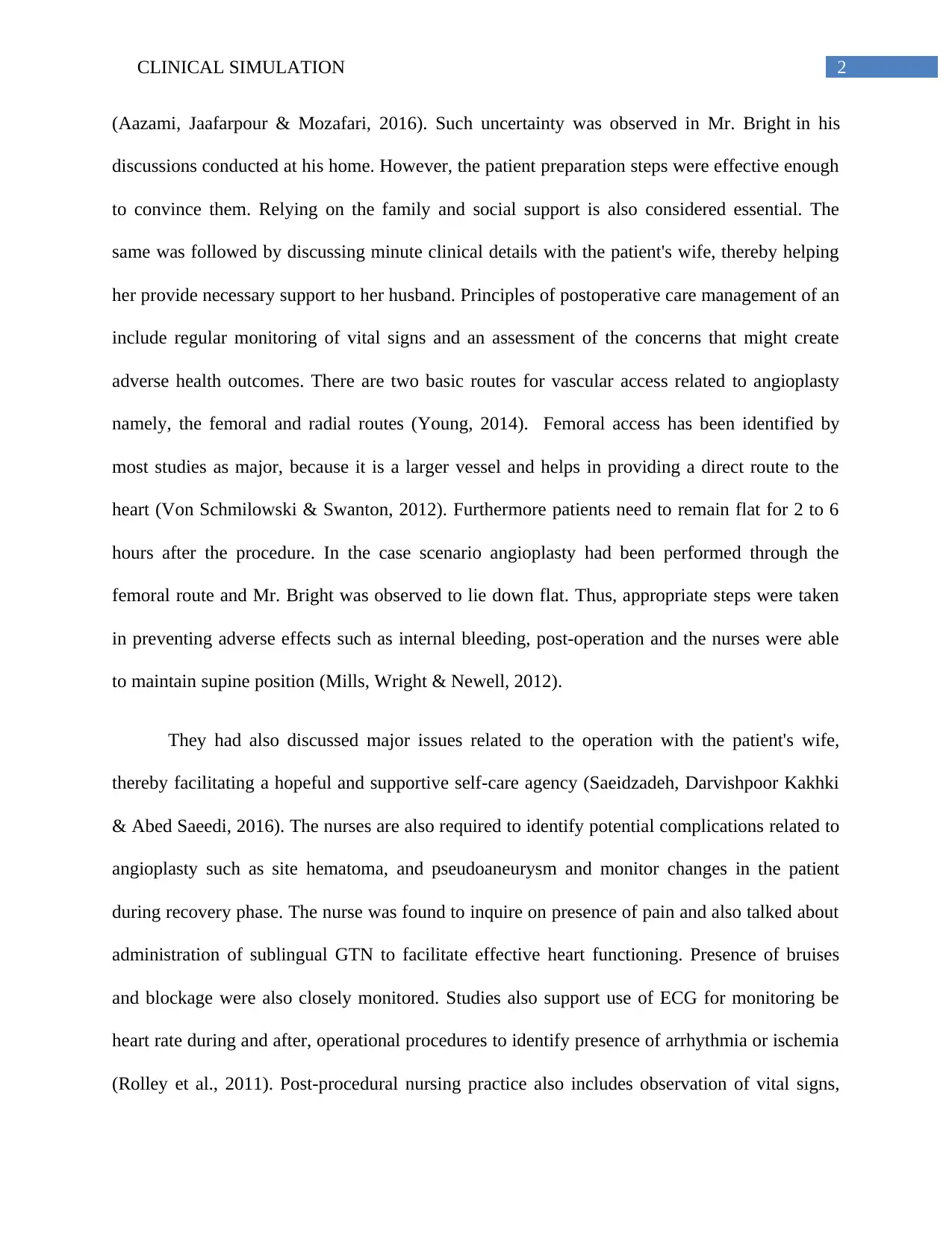
2CLINICAL SIMULATION
(Aazami, Jaafarpour & Mozafari, 2016). Such uncertainty was observed in Mr. Bright in his
discussions conducted at his home. However, the patient preparation steps were effective enough
to convince them. Relying on the family and social support is also considered essential. The
same was followed by discussing minute clinical details with the patient's wife, thereby helping
her provide necessary support to her husband. Principles of postoperative care management of an
include regular monitoring of vital signs and an assessment of the concerns that might create
adverse health outcomes. There are two basic routes for vascular access related to angioplasty
namely, the femoral and radial routes (Young, 2014). Femoral access has been identified by
most studies as major, because it is a larger vessel and helps in providing a direct route to the
heart (Von Schmilowski & Swanton, 2012). Furthermore patients need to remain flat for 2 to 6
hours after the procedure. In the case scenario angioplasty had been performed through the
femoral route and Mr. Bright was observed to lie down flat. Thus, appropriate steps were taken
in preventing adverse effects such as internal bleeding, post-operation and the nurses were able
to maintain supine position (Mills, Wright & Newell, 2012).
They had also discussed major issues related to the operation with the patient's wife,
thereby facilitating a hopeful and supportive self-care agency (Saeidzadeh, Darvishpoor Kakhki
& Abed Saeedi, 2016). The nurses are also required to identify potential complications related to
angioplasty such as site hematoma, and pseudoaneurysm and monitor changes in the patient
during recovery phase. The nurse was found to inquire on presence of pain and also talked about
administration of sublingual GTN to facilitate effective heart functioning. Presence of bruises
and blockage were also closely monitored. Studies also support use of ECG for monitoring be
heart rate during and after, operational procedures to identify presence of arrhythmia or ischemia
(Rolley et al., 2011). Post-procedural nursing practice also includes observation of vital signs,
(Aazami, Jaafarpour & Mozafari, 2016). Such uncertainty was observed in Mr. Bright in his
discussions conducted at his home. However, the patient preparation steps were effective enough
to convince them. Relying on the family and social support is also considered essential. The
same was followed by discussing minute clinical details with the patient's wife, thereby helping
her provide necessary support to her husband. Principles of postoperative care management of an
include regular monitoring of vital signs and an assessment of the concerns that might create
adverse health outcomes. There are two basic routes for vascular access related to angioplasty
namely, the femoral and radial routes (Young, 2014). Femoral access has been identified by
most studies as major, because it is a larger vessel and helps in providing a direct route to the
heart (Von Schmilowski & Swanton, 2012). Furthermore patients need to remain flat for 2 to 6
hours after the procedure. In the case scenario angioplasty had been performed through the
femoral route and Mr. Bright was observed to lie down flat. Thus, appropriate steps were taken
in preventing adverse effects such as internal bleeding, post-operation and the nurses were able
to maintain supine position (Mills, Wright & Newell, 2012).
They had also discussed major issues related to the operation with the patient's wife,
thereby facilitating a hopeful and supportive self-care agency (Saeidzadeh, Darvishpoor Kakhki
& Abed Saeedi, 2016). The nurses are also required to identify potential complications related to
angioplasty such as site hematoma, and pseudoaneurysm and monitor changes in the patient
during recovery phase. The nurse was found to inquire on presence of pain and also talked about
administration of sublingual GTN to facilitate effective heart functioning. Presence of bruises
and blockage were also closely monitored. Studies also support use of ECG for monitoring be
heart rate during and after, operational procedures to identify presence of arrhythmia or ischemia
(Rolley et al., 2011). Post-procedural nursing practice also includes observation of vital signs,
⊘ This is a preview!⊘
Do you want full access?
Subscribe today to unlock all pages.

Trusted by 1+ million students worldwide
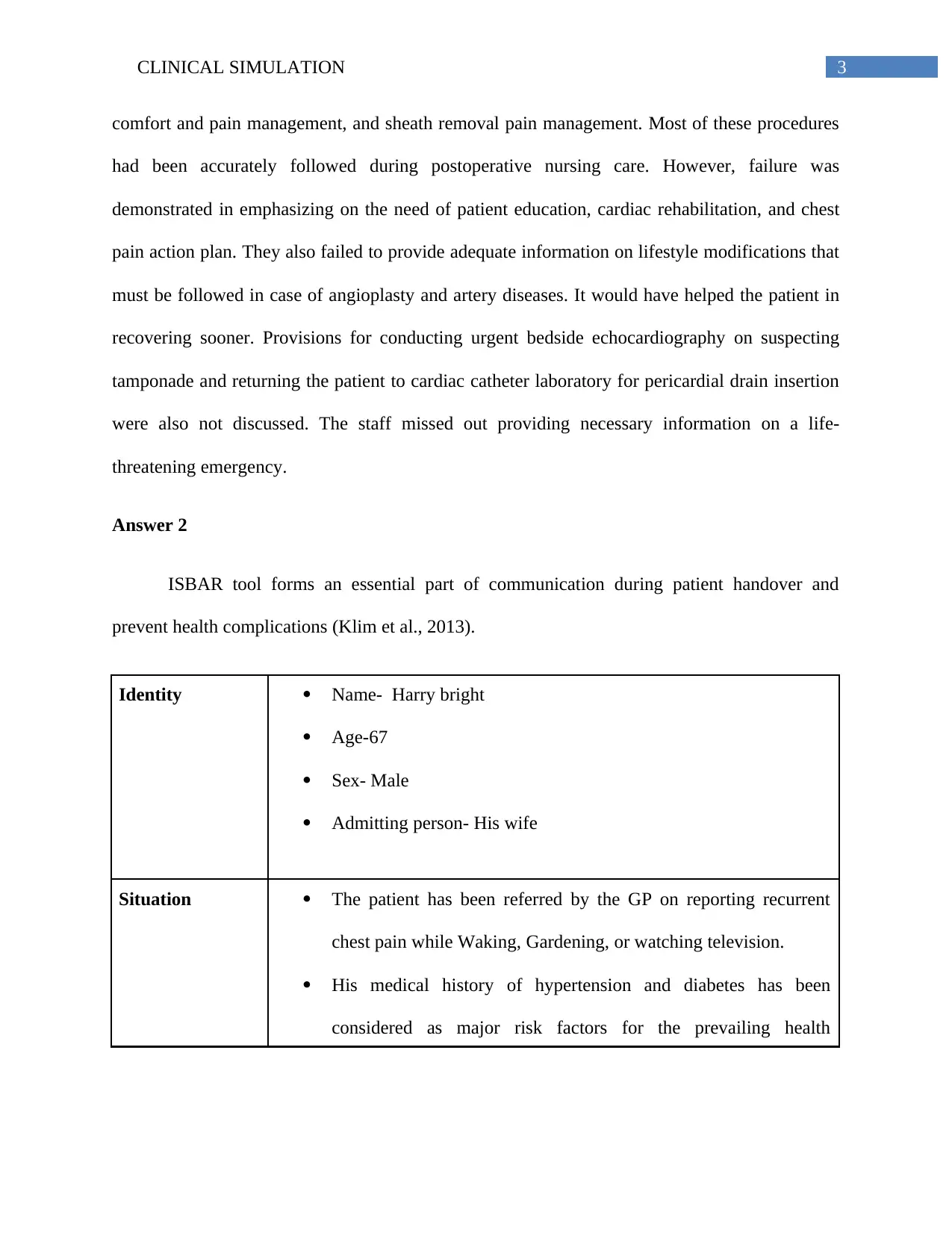
3CLINICAL SIMULATION
comfort and pain management, and sheath removal pain management. Most of these procedures
had been accurately followed during postoperative nursing care. However, failure was
demonstrated in emphasizing on the need of patient education, cardiac rehabilitation, and chest
pain action plan. They also failed to provide adequate information on lifestyle modifications that
must be followed in case of angioplasty and artery diseases. It would have helped the patient in
recovering sooner. Provisions for conducting urgent bedside echocardiography on suspecting
tamponade and returning the patient to cardiac catheter laboratory for pericardial drain insertion
were also not discussed. The staff missed out providing necessary information on a life-
threatening emergency.
Answer 2
ISBAR tool forms an essential part of communication during patient handover and
prevent health complications (Klim et al., 2013).
Identity Name- Harry bright
Age-67
Sex- Male
Admitting person- His wife
Situation The patient has been referred by the GP on reporting recurrent
chest pain while Waking, Gardening, or watching television.
His medical history of hypertension and diabetes has been
considered as major risk factors for the prevailing health
comfort and pain management, and sheath removal pain management. Most of these procedures
had been accurately followed during postoperative nursing care. However, failure was
demonstrated in emphasizing on the need of patient education, cardiac rehabilitation, and chest
pain action plan. They also failed to provide adequate information on lifestyle modifications that
must be followed in case of angioplasty and artery diseases. It would have helped the patient in
recovering sooner. Provisions for conducting urgent bedside echocardiography on suspecting
tamponade and returning the patient to cardiac catheter laboratory for pericardial drain insertion
were also not discussed. The staff missed out providing necessary information on a life-
threatening emergency.
Answer 2
ISBAR tool forms an essential part of communication during patient handover and
prevent health complications (Klim et al., 2013).
Identity Name- Harry bright
Age-67
Sex- Male
Admitting person- His wife
Situation The patient has been referred by the GP on reporting recurrent
chest pain while Waking, Gardening, or watching television.
His medical history of hypertension and diabetes has been
considered as major risk factors for the prevailing health
Paraphrase This Document
Need a fresh take? Get an instant paraphrase of this document with our AI Paraphraser
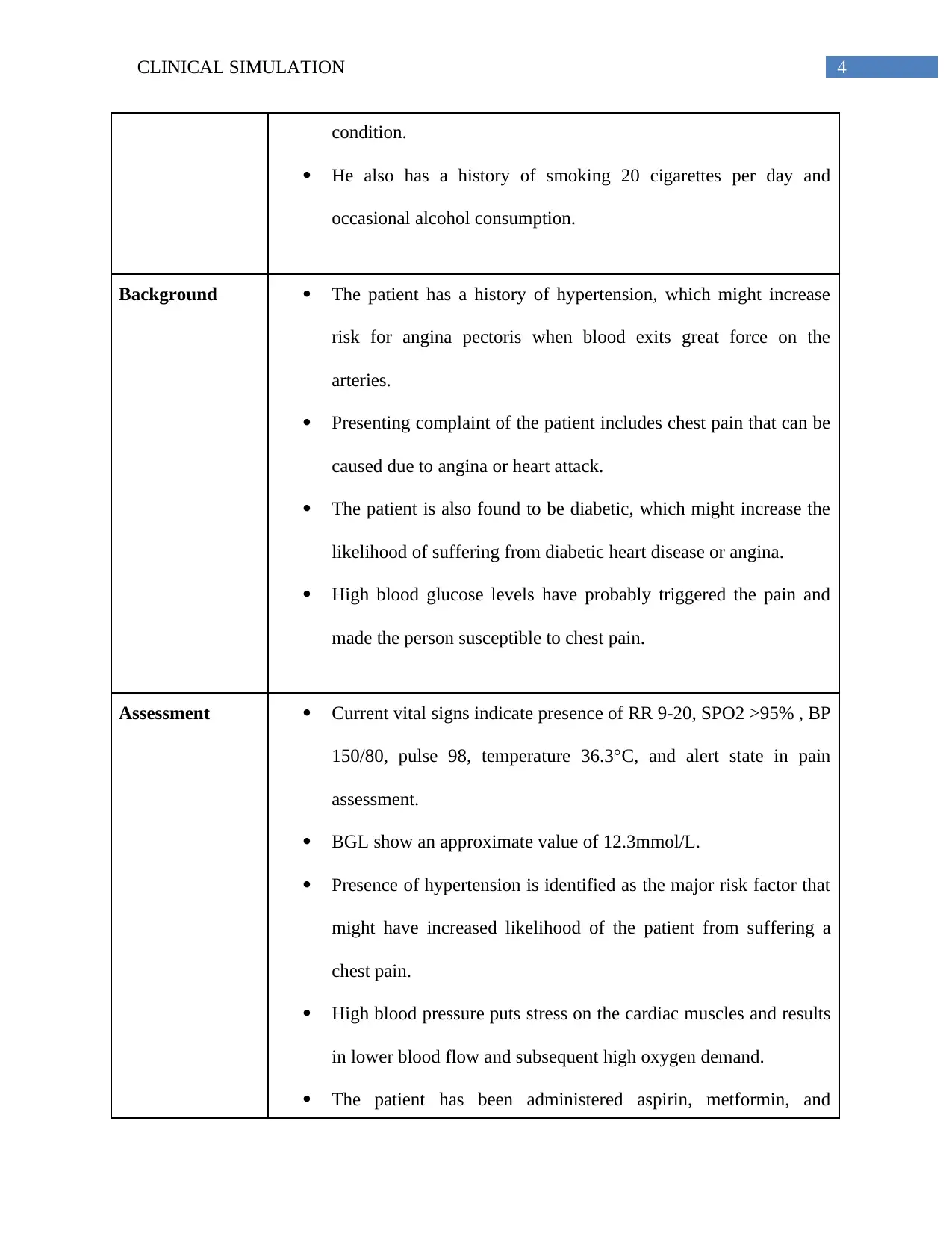
4CLINICAL SIMULATION
condition.
He also has a history of smoking 20 cigarettes per day and
occasional alcohol consumption.
Background The patient has a history of hypertension, which might increase
risk for angina pectoris when blood exits great force on the
arteries.
Presenting complaint of the patient includes chest pain that can be
caused due to angina or heart attack.
The patient is also found to be diabetic, which might increase the
likelihood of suffering from diabetic heart disease or angina.
High blood glucose levels have probably triggered the pain and
made the person susceptible to chest pain.
Assessment Current vital signs indicate presence of RR 9-20, SPO2 >95% , BP
150/80, pulse 98, temperature 36.3°C, and alert state in pain
assessment.
BGL show an approximate value of 12.3mmol/L.
Presence of hypertension is identified as the major risk factor that
might have increased likelihood of the patient from suffering a
chest pain.
High blood pressure puts stress on the cardiac muscles and results
in lower blood flow and subsequent high oxygen demand.
The patient has been administered aspirin, metformin, and
condition.
He also has a history of smoking 20 cigarettes per day and
occasional alcohol consumption.
Background The patient has a history of hypertension, which might increase
risk for angina pectoris when blood exits great force on the
arteries.
Presenting complaint of the patient includes chest pain that can be
caused due to angina or heart attack.
The patient is also found to be diabetic, which might increase the
likelihood of suffering from diabetic heart disease or angina.
High blood glucose levels have probably triggered the pain and
made the person susceptible to chest pain.
Assessment Current vital signs indicate presence of RR 9-20, SPO2 >95% , BP
150/80, pulse 98, temperature 36.3°C, and alert state in pain
assessment.
BGL show an approximate value of 12.3mmol/L.
Presence of hypertension is identified as the major risk factor that
might have increased likelihood of the patient from suffering a
chest pain.
High blood pressure puts stress on the cardiac muscles and results
in lower blood flow and subsequent high oxygen demand.
The patient has been administered aspirin, metformin, and
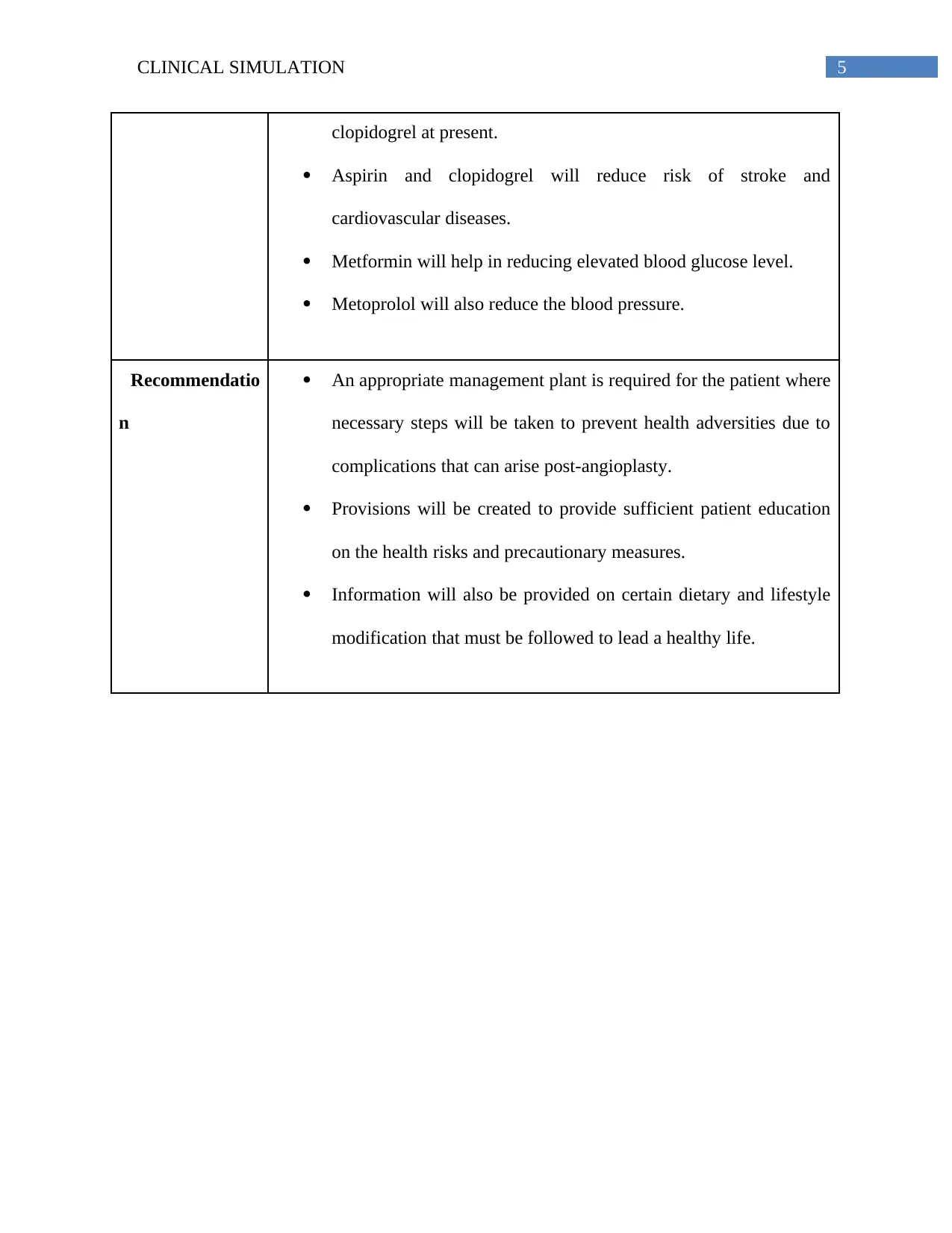
5CLINICAL SIMULATION
clopidogrel at present.
Aspirin and clopidogrel will reduce risk of stroke and
cardiovascular diseases.
Metformin will help in reducing elevated blood glucose level.
Metoprolol will also reduce the blood pressure.
Recommendatio
n
An appropriate management plant is required for the patient where
necessary steps will be taken to prevent health adversities due to
complications that can arise post-angioplasty.
Provisions will be created to provide sufficient patient education
on the health risks and precautionary measures.
Information will also be provided on certain dietary and lifestyle
modification that must be followed to lead a healthy life.
clopidogrel at present.
Aspirin and clopidogrel will reduce risk of stroke and
cardiovascular diseases.
Metformin will help in reducing elevated blood glucose level.
Metoprolol will also reduce the blood pressure.
Recommendatio
n
An appropriate management plant is required for the patient where
necessary steps will be taken to prevent health adversities due to
complications that can arise post-angioplasty.
Provisions will be created to provide sufficient patient education
on the health risks and precautionary measures.
Information will also be provided on certain dietary and lifestyle
modification that must be followed to lead a healthy life.
⊘ This is a preview!⊘
Do you want full access?
Subscribe today to unlock all pages.

Trusted by 1+ million students worldwide
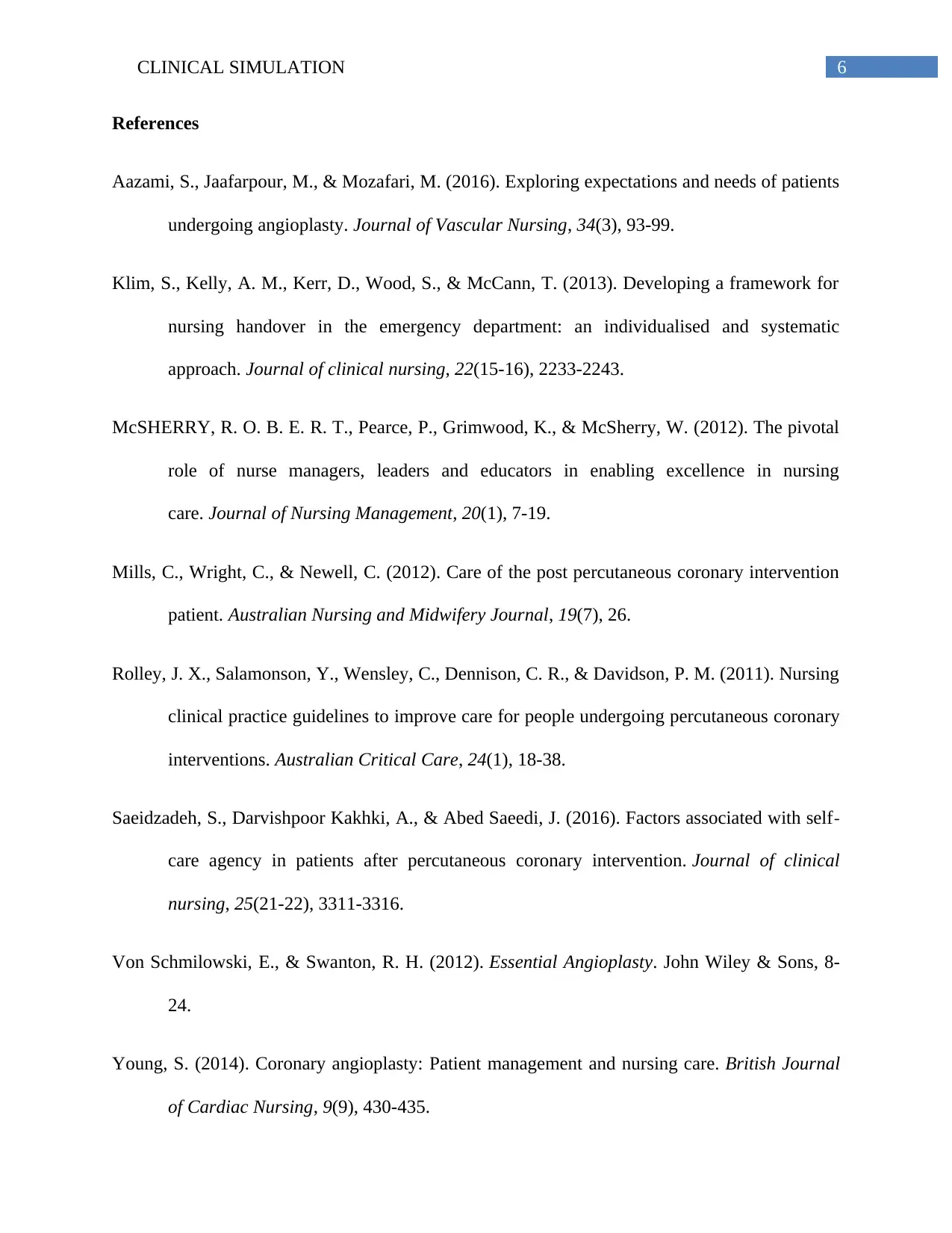
6CLINICAL SIMULATION
References
Aazami, S., Jaafarpour, M., & Mozafari, M. (2016). Exploring expectations and needs of patients
undergoing angioplasty. Journal of Vascular Nursing, 34(3), 93-99.
Klim, S., Kelly, A. M., Kerr, D., Wood, S., & McCann, T. (2013). Developing a framework for
nursing handover in the emergency department: an individualised and systematic
approach. Journal of clinical nursing, 22(15-16), 2233-2243.
McSHERRY, R. O. B. E. R. T., Pearce, P., Grimwood, K., & McSherry, W. (2012). The pivotal
role of nurse managers, leaders and educators in enabling excellence in nursing
care. Journal of Nursing Management, 20(1), 7-19.
Mills, C., Wright, C., & Newell, C. (2012). Care of the post percutaneous coronary intervention
patient. Australian Nursing and Midwifery Journal, 19(7), 26.
Rolley, J. X., Salamonson, Y., Wensley, C., Dennison, C. R., & Davidson, P. M. (2011). Nursing
clinical practice guidelines to improve care for people undergoing percutaneous coronary
interventions. Australian Critical Care, 24(1), 18-38.
Saeidzadeh, S., Darvishpoor Kakhki, A., & Abed Saeedi, J. (2016). Factors associated with self‐
care agency in patients after percutaneous coronary intervention. Journal of clinical
nursing, 25(21-22), 3311-3316.
Von Schmilowski, E., & Swanton, R. H. (2012). Essential Angioplasty. John Wiley & Sons, 8-
24.
Young, S. (2014). Coronary angioplasty: Patient management and nursing care. British Journal
of Cardiac Nursing, 9(9), 430-435.
References
Aazami, S., Jaafarpour, M., & Mozafari, M. (2016). Exploring expectations and needs of patients
undergoing angioplasty. Journal of Vascular Nursing, 34(3), 93-99.
Klim, S., Kelly, A. M., Kerr, D., Wood, S., & McCann, T. (2013). Developing a framework for
nursing handover in the emergency department: an individualised and systematic
approach. Journal of clinical nursing, 22(15-16), 2233-2243.
McSHERRY, R. O. B. E. R. T., Pearce, P., Grimwood, K., & McSherry, W. (2012). The pivotal
role of nurse managers, leaders and educators in enabling excellence in nursing
care. Journal of Nursing Management, 20(1), 7-19.
Mills, C., Wright, C., & Newell, C. (2012). Care of the post percutaneous coronary intervention
patient. Australian Nursing and Midwifery Journal, 19(7), 26.
Rolley, J. X., Salamonson, Y., Wensley, C., Dennison, C. R., & Davidson, P. M. (2011). Nursing
clinical practice guidelines to improve care for people undergoing percutaneous coronary
interventions. Australian Critical Care, 24(1), 18-38.
Saeidzadeh, S., Darvishpoor Kakhki, A., & Abed Saeedi, J. (2016). Factors associated with self‐
care agency in patients after percutaneous coronary intervention. Journal of clinical
nursing, 25(21-22), 3311-3316.
Von Schmilowski, E., & Swanton, R. H. (2012). Essential Angioplasty. John Wiley & Sons, 8-
24.
Young, S. (2014). Coronary angioplasty: Patient management and nursing care. British Journal
of Cardiac Nursing, 9(9), 430-435.
1 out of 7
Related Documents
Your All-in-One AI-Powered Toolkit for Academic Success.
+13062052269
info@desklib.com
Available 24*7 on WhatsApp / Email
![[object Object]](/_next/static/media/star-bottom.7253800d.svg)
Unlock your academic potential
Copyright © 2020–2025 A2Z Services. All Rights Reserved. Developed and managed by ZUCOL.





